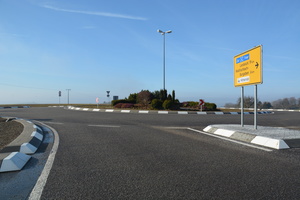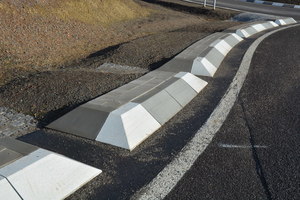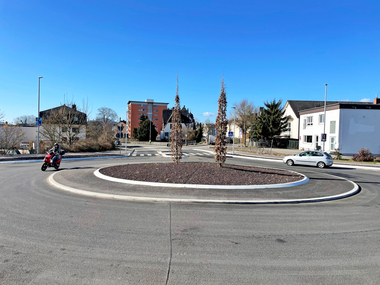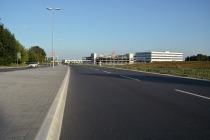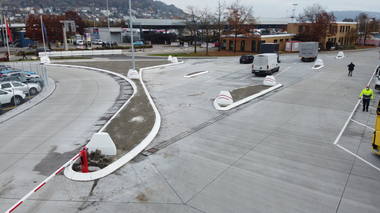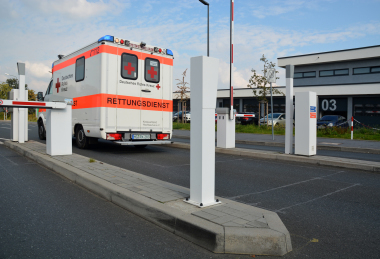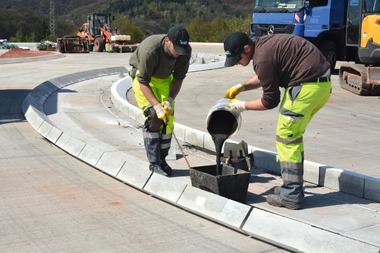Two bonded roundabouts for a new traffic link
AB 62, with a total length of only 79 kilometers, is among the shorter federal highways in Germany. It connects the city of Pirmasens on the northwestern edge of the Palatinate Forest with the township of Nonnweiler in the northern Saarland. An important partial highway section between the cities of Landstuhl and Pirmasens was completed only in the 1990s – due to the low traffic volume, however, with only one lane in each direction of travel along most of the route. In the course of further expansion of the A 62, a safety-enhanced and regulatory compliant link of the subsidiary networks has now been established in the form of two spatially separated roundabouts, built to replace the provisional traffic link via two parking lots near Höheinöd. The roundabouts were installed using the curbstone adhesive bonding technique, which has proven to be a highly cost-efficient solution for applications of this kind.
Up until the year 2014, traffic from the A 62 was provisionally detoured via a rest and service area near Höheinöd. While construction of the 4-lane expansion between Thaleischweiler-Fröschen and Bann was underway, it was necessary to discontinue this provisional arrangement, and planning for new construction began. In 2018, the construction of the Hoheinöd traffic link was completed within only eight months. Jens Schürmann of the Kaiserslautern Federal State Office for Mobility (Landesbetrieb Mobilität Kaiserslautern) explains the measure: “The western connection towards Pirmasens takes place from the existing traffic roundabout L 474/K 24 near that city via a short connecting prong approx. 125 m long, and continues via one-way lanes to the two existing access and exit lanes of the A 62.“
The new connecting prong, together with an additional connecting branch of the existing traffic roundabout L 474/K 24, was linked up to the subsidiary road network. The connection segment was executed as a two-lane roadway of 7.50 m width; the two one-lane ramps (access and exit) were broadened to a width of 6.0 m. The eastern connection towards Landstuhl to the subsidiary road network lies approx. 900 m to the north of AS West exit to district road No. 24. Here, the connection access and exit to the A 62 were planned with a so-called Dutch ramp. The expansion lengths of the one-lane ramps are around 260 m for the exits and approx. 220 m for the new access to the A 62. The ramps were also constructed with a traffic lane width of 6.0 m,” says Schürmann.
Roundabout installations are bonded to the completed road surface
Jens Schürmann explained the advantages of this construction method: “All the curbstones used here to form the curbs were bonded to the completed roadway instead of being conventionally installed. A great advantage of the bonding technique is that the flat curbstones are sawed already in the plant to exactly one height of 16 cm, thereby eliminating in this way production-related deviations in height – as well as calibrating, so to speak, the curbstones for bonding, This virtually eliminates dimensional tolerances. Bonding takes place by means of the thin-bed bonding process, for which the 2-K dual-component synthetic material is applied to the asphalt, which is cleaned with high water pressure. The curbstones are bonded on the cut side. The adhesive adheres especially well to the smooth surface, the thin layer of cement having been removed by the cutting process,” explains Schürmann. Another advantage: thanks to the many radii and molded blocks that the Meudt product range comprises, the roadway divisions and roadway edging can be implemented virtually without cutting.
Good traffic management effect thanks to the zebra stripe look
Because of the danger from curbstone edges being repeatedly bumped into or run over by heavy-duty traffic, the flat curbstones of the inner circle and the outer border were reinforced with two rows of 16/16/16 paving blocks glued to the back. Perceptibility of the bonded-on flat curbstones (FB 30 x 25) was enhanced by their optical design. These are alternately colored in white and gray, ensuring in this way a good traffic management effect – much like that achieved with zebra crossings. Surface water from the L 474 and the K 24 is drained into rainwater retention basins via drainage channels, gullies and drainage pipes around the existing traffic roundabout. The curbs are provided with openings.
The cost for the construction works of the traffic link alone totaled 1.8 million euros, 81 % of which was assumed by the German Federal Government, and 19 % by the Southwest Palatinate District Council.

